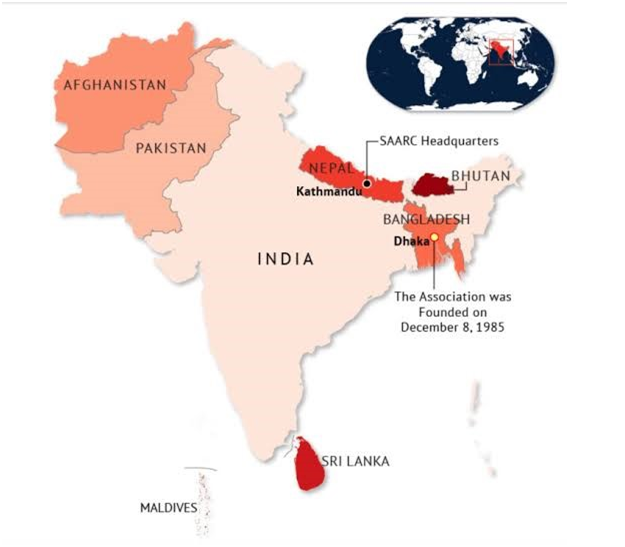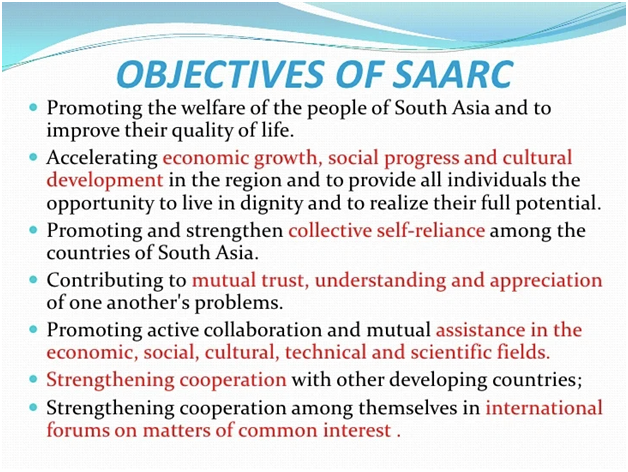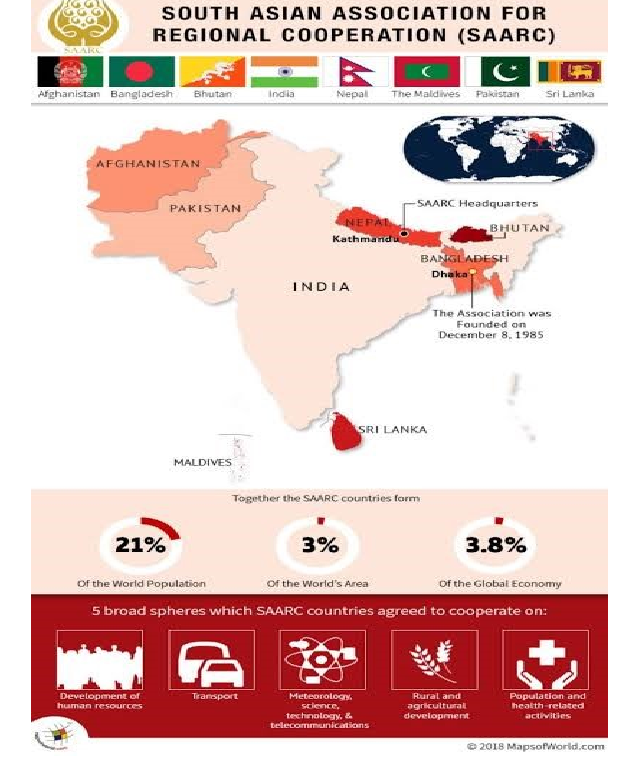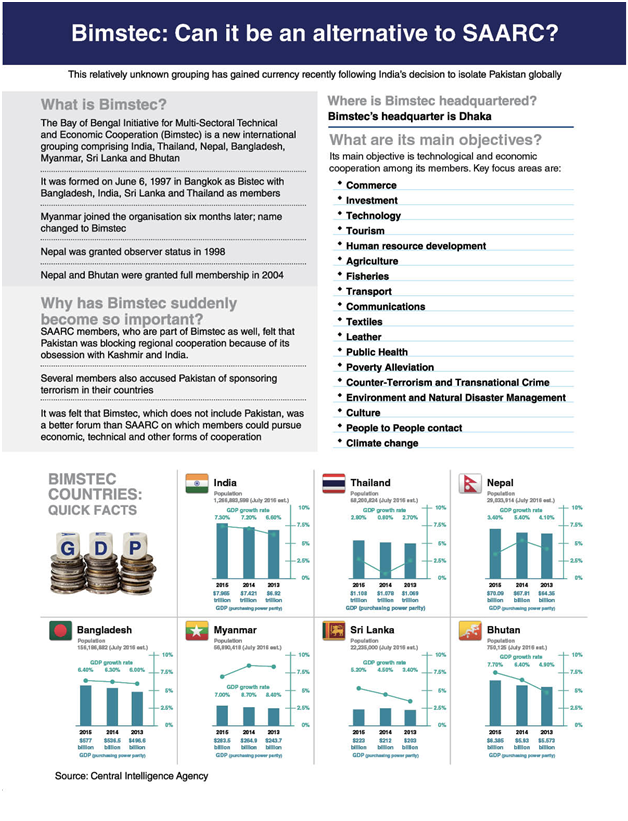BIMSTEC as key to a new South Asian regional order
South Asian Association for Regional Cooperation(SAARC):
- The SAARC was established with the signing of the SAARC Charter in Dhaka on 8 December 1985.
- Founding countries—Bangladesh, Bhutan, India, Maldives, Nepal, Pakistan, and Sri Lanka.
- Afghanistan joined SAARC at the 13th annual summit in 2005.
- The Headquarters and Secretariat of the Association are at Kathmandu, Nepal.
- Cooperation within the framework of the SAARC is based on:
- Respect for the principles of sovereign equality
- Territorial integrity
- Political independence
- Non-interference in the internal affairs of other States
- Mutual benefit.
- Areas of Cooperation:
- Human Resource Development and Tourism
- Agriculture and Rural Development
- Environment, Natural Disasters and Biotechnology
- Economic, Trade and Finance
- Social Affairs
- Information and Poverty Alleviation
- Energy, Transport, Science and Technology
- Education, Security and Culture and Others
Issues with the SAARC:
- Poverty: South Asia continues to be an extremely poor and least integrated region in the world.
- When compared to other regions like the Association of SouthEast Asian Nations (ASEAN) and Sub-Saharan Africa, South Asia’s intra regional trade and investment are quite low.
- By continually opposing important measures like the motor vehicles accord, which is intended to improve regional connectivity, Pakistan has chosen an obstructionist stance within SAARC.
- Things have gotten worse as India and Pakistan’s enmity has grown.
- Since 2014: No SAARC summit has taken place leaving the organization rudderless, and practically dead.
Importance of SAARC:
- The only intergovernmental group that spans all of South Asia is SAARC.
- India can use it wisely to further its goals throughout the entire region.
- Soft power: The South Asian University (SAU), which is essential to India’s soft power in the region, and other potential regional institutions will be more unstable if SAARC is weaker.
Significance of regionalism:
- Other regions, including East Asia and Africa, have had tremendous development because of regionalism.
- Because multilateralism is waning, regionalism can provide prosperity to the South Asian region.
Bay of Bengal Initiative for Multi-Sectoral, Technical and Economic Cooperation (BIMSTEC):
- It is an intergovernmental organization established in 1997.
- BIMSTEC comprises:
- Five South Asian nations (Bangladesh, Bhutan, Nepal, India and Sri Lanka)
- Two ASEAN countries (Myanmar and Thailand).
Why is BIMSTEC charter better than SAARC?
- Article 6: Unlike the SAARC Charter, Article 6 of the BIMSTEC Charter talks about the ‘Admission of new members’ to the group.
- This paves the way for the admission of countries such as the Maldives.
- BIMSTEC Charter, to boost economic integration: It does not contain the flexible participation scheme of the kind present in the ASEAN Charter.
- No country enjoys veto power to thwart economic integration between willing countries: BIMSTEC does not contain a flexible participation scheme.
Way Forward
- Bilateralism: India can successfully use the instrument of bilateralism over regionalism to pursue its interests.
- Although bilateral initiatives are crucial, they cannot replace regional or international ones.
- The best course of action will be to revitalize SAARC by injecting political vitality into it and amending its outdated Charter.
- Flexible “BIMSTEC Minus X” formula: It might let ongoing bilateral free trade agreement (FTA) negotiations between India and Thailand or India and Bangladesh to take place under the broader BIMSTEC framework.
- It will enable the gradual and incremental expansion of these binding commitments to other members.
- Amendments: India should press for this amendment in the BIMSTEC Charter.
- BIMSTEC should not end up as another SAARC: Member countries should raise the stakes.
- A high-quality FTA offering deep economic integration would be an ideal step.
- India should explore legal ways: to move successful SAARC institutions such as SAU to BIMSTEC.
- These steps will give stronger roots to BIMSTEC
- It will enable erecting a new South Asian regional order based on incrementalism and flexibility.
QUESTION FOR MAINS
- Do you think that BIMSTEC is a parallel organization like the SAARC ? What are the similarities and dissimilarities between the two ? How are Indian foreign policy objectives realized by forming this new organization?(UPSC 2022) (200 WORDS, 10 MARKS)







